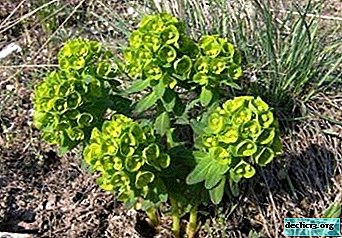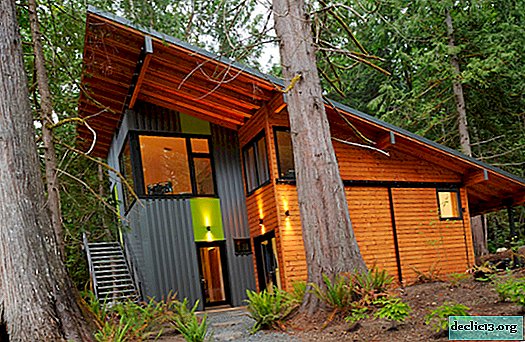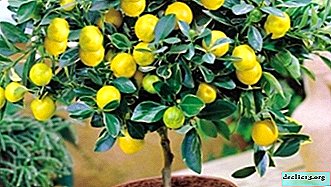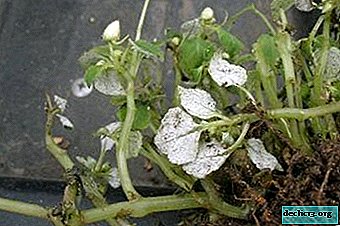Variety of succulent adromiscus. Description and photo species: Cooper, Spotted and others
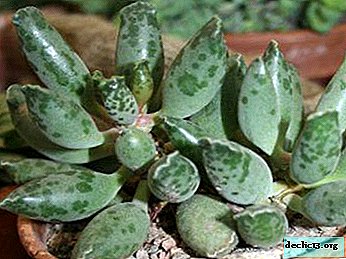
Adromiscus is a succulent plant in the family Crassulaceae. It comes from South and South-West Africa, and got its name from two Greek words: "adros" - thick and "mischos" - trunk. It looks like a undersized (3-5 cm tall) shrub with a short lying stalk and juicy, fleshy leaves. It is appreciated for its unusual leaves in shape and texture, but flowering is not very attractive. This is a flowering plant with many species. In the article, we will study in detail each species of this plant.
Names, description of Adromischus species and photo
According to researchers, there are from 50 to 70 different species of Adromiscus. All species have both common and various features, but only some varieties are grown in room conditions. Let us consider in more detail the characteristics of the most popular representatives.
Tri-pistil (Trigynus)
In the people it is called "three-column". This type of plant has short stems and grows up to 10 cm long. The leaves are elongated and pointed, gray-green with reddish-brown spots on both sides, closer to the upper edge. The length of the leaves is on average up to 5 cm and a width of 3-4 cm. The flower tube is light at the base and red-brown to the edge.

Comb (Cristatus schoenlandii)
Another name is Adromiscus cristatus - it is a small succulent plant growing in length up to 15 cm. Its feature is upright stems at a young age, which over time sag (or crawl) and become overgrown with many reddish-colored aerial roots. It differs in the wavy edge of leaves having the shape of a convex inverted triangle of light green or dark green color.
The leaflets reach a length of up to 5 cm, and a width of up to 3 cm and are arranged on a short stem, collected in a socket. The ground part of the plant is covered with small white villi. Blooms Adromiskus combed buds of white-green color with a pinkish edging on the edge.

Copper or Cooper (Cooperi)
It is considered the most common and easy to grow. A miniature erect plant with a very short, highly branched stem. It grows to a height of 10 cm and has shiny, green pillow-shaped leaves with red-brown spots, which are especially clearly manifested in bright sunshine. The sheet plate is glossy, smooth, oval in shape with a slightly wavy edge, up to 5 cm in length.
The inflorescence forms an ear shape, in which tubular flowers, each measuring up to 1.5 cm in size, are located along a long peduncle. Five fused petals of red-green color at the edges have a white, pink or purple hue.
Regarding the care of Cooper's adromiscus at home, it is important to observe the main rule - to provide the maximum amount of light, because the plant is extremely photophilous, accustomed to high air temperatures. Window sills on the south side of the house are ideal as a habitat. For normal development, he needs a temperature of + 25-30 degrees and regular ventilation of the room.
In general, adromiscus do not tolerate cold, but according to some reports, Adromiscus Cooper is able to survive short-term frosts with temperatures up to -7 degrees. The root system reacts sharply to excessive moisture, so watering should be carried out only after the substrate has completely dried. Do not be afraid to dry the soil, because the plant is accustomed to drought.
Important: Do not allow moisture to get on the leaves. because they can rot.It is better to feed with mineral fertilizers with low concentration.

Pelnitsa (Poellnitzianus)
The branching of this species of Adromiscus begins directly from the base with short light green stems., smooth and narrow below, and gradually expanding closer to a flat edge, covered with barely noticeable white villi.
In height, an adult bush reaches only 10 cm. The inflorescence is nondescript, has a creeping character and reaches a length of up to 40 cm. The flowers are very small, white-green in color.

Spotted (Maculatus)
It differs in weak branching, but more stable upright stalk, reaching a length of up to 10 cm. From the very base, the stalk is framed by round or oval leaves.
Dark green leaf blades covered with decorative oval burgundy spots, grow up to 5 cm in length, and about 3 cm in width. The plant blooms with red-brown buds collected in a spike-shaped inflorescence.

Read more about spotted Adromiscus here.
Schuldtianus
The main difference between this species of Adromiscus was its leaves - ovoid, covered with a gray monophonic film. The tip of the sheet is slightly pointed and painted in a burgundy hue.

Marianae
Incredibly beautiful and the most volatile representative of all species. Its leaves can be round in shape about 0.9 cm (or even less) in length, and can stretch up to 10 cm with a thickness of up to 2 cm. The texture is also varied - from smooth to tuberous.
The color is very bright, reddish, due to which the leaves are compared with pieces of lava. The most photophilous plant in need of constant brightest lighting.
Reference: if Adromiscus mariana is deficient in sunlight, its leaves will lose their brightness and will eventually acquire the usual green color.Also a distinctive feature of the species can be called extremely slow growth. All succulent collectors are eager to get this copy.

Refined (Festivus)
Other names for this species are Adromiscus festive or festival. It has juicy hard leaves of a gray-green or silver hue, with red-brown spots. In length, the leaves grow to 3-5 cm, and only 1 cm wide. At the end, they are slightly narrowed, with a wavy edge. The stems are short and very thin at the base. The whole plant hardly exceeds 10 cm in height.

Halesowensis (Halesowensis)
The difference of this species lies in the unusual shape of the leaves - narrowed at the base, they gradually expand and end with a small sternum at the tip. In length, leaves grow by 5-7 cm, and in width up to 2.5 cm.
The color is pale silver-green, the leaf blade is glossy with small wax points closer to the edge. Flowers are single, green-red-brown. The buds grow about 1 cm in length, that is, they are not very large and noticeable.

Grooved, or Alveolatus (Alveolatus)
The name "grooved" plant received due to the presence of a small groove on the fleshy leaves. The leaf blade is very rough, thick, grows up to 3.5 cm in length and up to 2 cm in width. The stems are only 1.5-2 cm long and up to 5 mm in diameter.
Despite its small dimensions, the flower stem extends up to 25 cm in height. It is strewn with single pale pink buds on a white leg, consisting of 5 petals soldered together. Adromischus grows grooved very slowly, in the process acquiring aerial roots, which eventually dry up and darken.

Zeyheri (Zeyheri)
Adromiscus Zeuerus is considered a subspecies of Adromiscus cristatus. Unlike other species, the stem of the plant is significantly developed, up to 8 cm in length, knotty and has no aerial roots. The leaves are large, flat yellow-green juicy color grow up to 7 cm in length and have an oval-triangular shape. The flowers are small, painted in cream color, located on flowering stems, reaching a height of 60 cm.

In conclusion, it can be noted that Adromiscus is a rather unpretentious plant.

